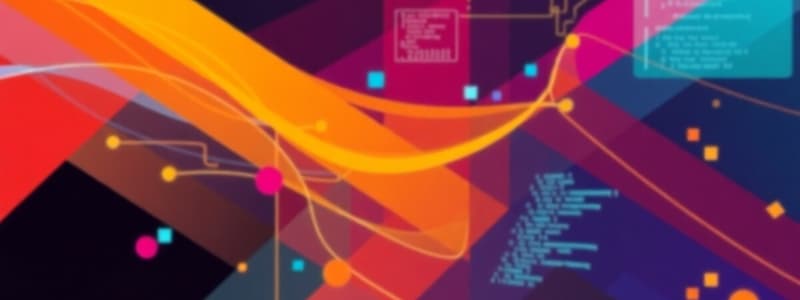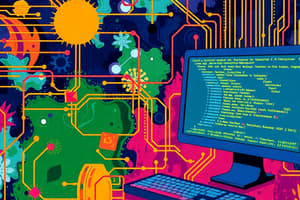Podcast
Questions and Answers
What is a computer? List the characteristics of a computer.
What is a computer? List the characteristics of a computer.
A computer is an electronic device that can accept data (input), process it according to instructions (program), and produce results (output). Characteristics of a computer:
- Speed: Computers can process data very quickly.
- Accuracy: Computers are very accurate and rarely make mistakes.
- Storage: Computers can store vast amounts of data.
- Versatility: Computers can be used for a wide variety of tasks.
- Automation: Computers can perform tasks automatically.
- Communication: Computers can communicate with other computers.
- Reliability: Computers are generally reliable and consistent.
- Automatic operation : Computers can be programmed to perform tasks without human intervention.
- Memory: Computers can store data and programs for later use.
What is software? Mention the types.
What is software? Mention the types.
Software refers to the set of instructions or programs that tell a computer what to do. It is the intangible part of a computer system that enables it to perform specific tasks. Types of software:
- System Software: These programs manage the basic functions of a computer, such as operating systems (Windows, macOS, Linux), device drivers, and utilities.
- Application Software: These programs are designed to perform specific tasks for users, such as word processors, spreadsheets, web browsers, and games.
- Programming Software: This software helps developers create other software programs. It includes programming languages, compilers, interpreters, and debuggers.
Define compiler and linker.
Define compiler and linker.
Compiler and linker are crucial tools in the software development process.
- Compiler: A compiler translates high-level programming code (written in a human-readable language like C++, Java, Python) into low-level machine code that the computer can understand and execute. It takes the entire program as input and generates an executable file as output.
- Linker: A linker combines multiple object files (compiled code) into a single executable file. It resolves references between different parts of the program and creates a final program that can be run on the computer.
Mention any four header files.
Mention any four header files.
What is an array? How to initialize an array?
What is an array? How to initialize an array?
Define structure and union.
Define structure and union.
What is a C token? List the C tokens.
What is a C token? List the C tokens.
Mention the basic data types and their size in bytes.
Mention the basic data types and their size in bytes.
What is machine level language and high-level language?
What is machine level language and high-level language?
What are formal parameters and actual parameters?
What are formal parameters and actual parameters?
What is an algorithm? Write an algorithm for the largest of three numbers.
What is an algorithm? Write an algorithm for the largest of three numbers.
What is flowchart? What are the symbols used for drawing a flowchart?
What is flowchart? What are the symbols used for drawing a flowchart?
Flashcards
What is a computer?
What is a computer?
A computer is an electronic device that receives, processes, and outputs data. It operates under the control of instructions called software.
What is software?
What is software?
Software refers to a set of instructions that tell a computer what to do. It includes programs, apps, and operating systems.
What is a compiler?
What is a compiler?
A compiler translates high-level programming code into machine-readable instructions that the computer can execute.
What is a linker?
What is a linker?
Signup and view all the flashcards
Mention any four header files.
Mention any four header files.
Signup and view all the flashcards
What is an array?
What is an array?
Signup and view all the flashcards
Define structure and union.
Define structure and union.
Signup and view all the flashcards
What is a C token?
What is a C token?
Signup and view all the flashcards
Mention the basic data types and their size in bytes.
Mention the basic data types and their size in bytes.
Signup and view all the flashcards
What is machine level language and high level language?
What is machine level language and high level language?
Signup and view all the flashcards
What is formal parameters and actual parameters?
What is formal parameters and actual parameters?
Signup and view all the flashcards
What is an algorithm?
What is an algorithm?
Signup and view all the flashcards
What is a flowchart?
What is a flowchart?
Signup and view all the flashcards
Flowchart Symbols
Flowchart Symbols
Signup and view all the flashcards
What is a variable?
What is a variable?
Signup and view all the flashcards
What is an operator?
What is an operator?
Signup and view all the flashcards
What is a loop?
What is a loop?
Signup and view all the flashcards
What is a function?
What is a function?
Signup and view all the flashcards
What is a conditional statement?
What is a conditional statement?
Signup and view all the flashcards
What is an expression?
What is an expression?
Signup and view all the flashcards
What is a statement?
What is a statement?
Signup and view all the flashcards
Study Notes
Part A - Short Answer Questions
- What is a computer? A computer is an electronic device that can accept, store, process, and output data according to a set of instructions.
- Computer Characteristics: Computers exhibit characteristics like: speed, accuracy, reliability, versatility, and storage capacity. They can also be categorized as digital, analog, and hybrid depending on how they handle data.
- What is software? Software consists of a set of instructions, data, or programs used to operate a computer. Different types include system software (like operating system) and application software (like word processors).
- Compiler and Linker: A compiler translates a source code program into an object code program. A linker combines object code files to create an executable file.
- Header Files: Header files contain declarations of functions and variables, which are essential for a program to work properly and efficiently. Examples include stdio.h, stdlib.h, math.h, and string.h.
- Arrays: An array is a collection of similar data type elements stored in contiguous memory locations. Array initialization involves assigning values to array elements before use.
- Structures and Unions: Structures group data items of different types into a single unit, while unions allocate the same memory space to different data types.
- C Tokens: C tokens represent the smallest individual units in a C program, including keywords, identifiers, constants, operators, and punctuators.
- Basic Data Types and Size (in bytes): Basic C data types such as integer, float, double, character, and pointers have standard memory sizes depending on the compiler and architecture. The specific sizes should be verified. .
- Machine Level vs High-Level Languages: Machine language is low-level code directly understood by a computer's processor, while high-level languages (like C) require translation to machine code by compilers.
- Formal and Actual Parameters: Formal parameters are placeholders in a function definition, while actual parameters are the values used when a function is called.
Part B - Detailed Answer Questions
- Algorithm for Largest of 3 Numbers: An algorithm for finding the largest of three numbers involves comparing each number to determine the greatest value. Pseudo code would be to first compare first two numbers, then the result of the comparison to the third number.
- What is a Flowchart? A flowchart is a visual representation of an algorithm using standardized symbols (like rectangles, diamonds, and parallelograms). The flow chart is used to represent the execution path of a program visually. Symbols help represent decisions (if-else) and loops to help understand programming logic flow more easily.
Studying That Suits You
Use AI to generate personalized quizzes and flashcards to suit your learning preferences.




